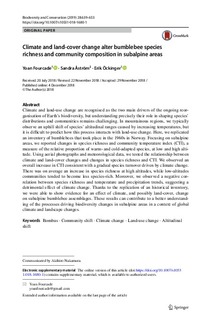Climate and land‑cover change alter bumblebee species richness and community composition in subalpine areas
Journal article, Peer reviewed
Published version

Åpne
Permanent lenke
http://hdl.handle.net/11250/2604958Utgivelsesdato
2019Metadata
Vis full innførselSamlinger
- Publikasjoner fra CRIStin - NINA [2364]
- Scientific publications [1392]
Sammendrag
Climate and land-use change are recognised as the two main drivers of the ongoing reorganisation of Earth’s biodiversity, but understanding precisely their role in shaping species’ distributions and communities remains challenging. In mountainous regions, we typically observe an uphill shift of species’ altitudinal ranges caused by increasing temperatures, but it is difficult to predict how this process interacts with land-use change. Here, we replicated an inventory of bumblebees that took place in the 1960s in Norway. Focusing on subalpine areas, we reported changes in species richness and community temperature index (CTI), a measure of the relative proportion of warm- and cold-adapted species, at low and high altitude. Using aerial photographs and meteorological data, we tested the relationship between climate and land-cover changes and changes in species richness and CTI. We observed an overall increase in CTI consistent with a gradual species turnover driven by climate change. There was on average an increase in species richness at high altitudes, while low-altitudes communities tended to become less species-rich. Moreover, we observed a negative correlation between species richness and temperature and precipitation trends, suggesting a detrimental effect of climate change. Thanks to the replication of an historical inventory, we were able to show evidence for an effect of climate, and possibly land-cover, change on subalpine bumblebee assemblages. These results can contribute to a better understanding of the processes driving biodiversity changes in subalpine areas in a context of global climate and landscape changes. Bombus Community shift · Climate change · Land-use change · Altitudinal shift
